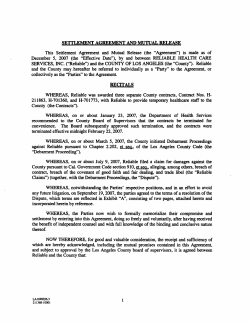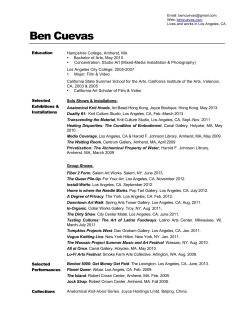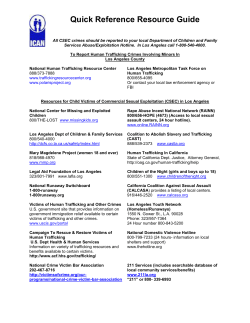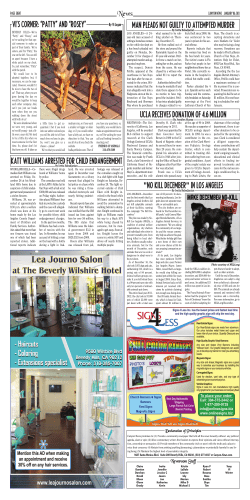
Q A &
Q&A Proposed CDO Streamlining Ordinance August 2010 Q: What is being proposed? A: The Department of City Planning is proposing an ordinance that would allow for administrative review of projects when they are fully compliant with design guidelines and standards contained in Community Design Overlay Districts. Q: What does that actually mean? A: The purpose of these changes is to reduce the process length of time for projects that meet CDOs. Basically, if a project complies with all a CDO’s guidelines and standards, applicants would get a meeting and approval relatively quickly instead of waiting for Planning to issue a determination letter that authorizes the approval. If a project doesn’t meet all the standards, but still generally meets the intent of the CDO by meeting the guidelines, a determination letter will be written up detailing what is in compliance and how. Q: Does this take away regulations? (Read: Does this make it easier to build uglier buildings?) A: No! All adopted CDO standards remain as is! Projects in CDO districts are still subject to CDO provisions. In fact, CDO standards are technically not regulations or law, which is why we are focusing streamlining on this process. If anything, streamlining the process provides an incentive for property owners and developers to meet the guidelines and save time in the permit process. Q: Why is this being proposed? A: With Planning Department staffing levels at almost half of our anticipated levels, and continuous additions of special zoning overlays and plans that require staff’s attention, we have fewer Planners and more work (with legally-mandate deadlines!). We must prioritize and focus our limited resources. The proposed ordinance reduces timelines and staff expenditures, while not changing or undermining the guidelines or standards that apply to projects. Q: Why am I just hearing about it now? A: This is the perfect time to hear about it! These public information meetings are just an initial step in reaching out; the goal is to explain what we are proposing so that we can receive your input. Your comments are welcome throughout September (in order to be incorporated in to the staff report), and beyond; you can continue participating at the City Planning Commission Hearing (yet to be scheduled) and the Planning and Land Use Management Committee of Council (PLUM) and City Council. Please sign in to be on the mailing list for future meetings. Q: Wasn’t this already proposed? A: Yes! In 2007 the Planning Department proposed CDO streamlining, which was approved by the City Planning Commission without much fanfare. The ordinance at the time defined types of projects that could receive sign-offs (also known as administrative clearances). Given further budgetary restrictions in recent times, and because the City Attorney had concerns about defining signs as minor projects, we decided that a more comprehensive version of the CDO streamlining ordinance would be most effective. We are now bringing it back though public review. Q: Is this the same thing as the “Core Findings” Code Amendment? A: No! The CDO streamlining ordinance is coming from the Community Planning Bureau, a portion of the Planning Department that is responsible for creating and “implementing” the CDOs (that means reviewing projects and making sure the plans are followed). The Core Findings and Code Simplification efforts are being done by a different section of the Planning Department, the Code Studies unit, in order to make findings consistent throughout the Los Angeles Municipal Code. Q: Why is the CDO Streamlining and Citywide Design Guidelines meeting combined? A: We devised a combined meeting as an innovative way to maximize attendance and draw in people who may have heard about one but not the other. A combined meeting also conserves resources (for example shared staffing cuts down on costs) and helps staff coordinate and learn from each other. ?: If you have other questions—or comments—please contact Shana Bonstin, Phone: 213.978.1207 Mail: Department of City Planning Fax: 213.-978.1226 200 N. Spring Street, Room 621 Email: [email protected] Los Angeles, CA 90039 ORDINANCE NO. _______________ An ordinance amending Section 13.08 of the Los Angeles Municipal Code relating to Community Design Overlay Districts. THE PEOPLE OF THE CITY OF LOS ANGELES DO ORDAIN AS FOLLOWS: Section 1. Subsection C of Section 13.08 of the Los Angeles Municipal Code is amended by amending the following definition in proper alphabetic order to read: 2. Project. The erection, construction, addition to, or exterior structural alteration of any building or structure, including, but not limited to, pole signs and/or monument signs located in a Community Design Overlay District. This includes any alteration to a building façade fronting a public street, regardless of the aggregate value of the work. EXEMPTION: A Project does not include construction that consists of: (a) interior remodeling, interior rehabilitation or repair work; (b) exterior alterations of, including structural repairs, or additions to any existing building or structure in which the aggregate value of the work, in any one 24-month period, is less than 50 percent of the building or structure’s replacement value before the alterations or additions, as determined by the Department of Building and Safety, unless the alterations or additions are to any building facade facing a public street; or (c) a residential building on a parcel or lot which is developed entirely as a residential use and consists of four or fewer dwelling units, unless expressly provided for in a Community Design Overlay District established pursuant to this section. Section 2. Subsection E of Section 13.08 of the Los Angeles Municipal Code is amended to read: E. Design Overlay Plan Approvals. Within a Community Design Overlay District, no building permit shall be issued for any project, no certificate of occupancy shall be issued and no person shall perform any construction work on a Project, until either a Design Overlay Plan Determination has been approved or a Planning Department Administrative Clearance has been completed according to the following procedures: EXCEPTION: 1 No Design Overlay Plan approval shall be required for any project until the Guidelines and Standards have been approved. 1. Approval Authority. The Director of Planning, or his or her designee, shall approve or conditionally approve Design Overlay Plans if the plans comply with the provisions of approved Community Design Guidelines and Standards. An approval of a Design Overlay Plan by the Director of Planning, or his or her designee, shall be appealable to the Area Planning Commission. 2. Procedures. (a) Application. An application for a Design Overlay Plan approval shall be filed with the Department of City Planning on the prescribed form, and shall be accompanied by any required materials. The application shall not be considered complete unless and until the form has been properly completed, all required information has been provided and the filing fee set forth in Section 19.01 of this Code has been paid. (b) Action of Director – Administrative Clearance or Director’s Determination. The Director shall determine if the application qualifies for an Administrative Clearance or Director’s Determination. A Project that fully complies with all applicable Guidelines and Standards of an adopted CDO District shall submit plans to the Director for Administrative Clearance pursuant to Section 12.32 S 4. Projects that do not qualify for Administrative Clearance are eligible for a Director’s Determination. The Director of Planning, or his or her designee, shall make a Director’s Determination within 75 working days from the date of the filing of a completed application and the payment of the applicable fee. This time limit may be extended by mutual written agreement of the applicant and the Director. (c) Transfer of Jurisdiction for Director’s Determination. If the Director or his or her designee fails to make a Director’s Determination within the prescribed time period, the applicant may file a request for a transfer of jurisdiction to the Area Planning Commission for a determination on the original application, in which case, the Director shall lose jurisdiction. This request shall be filed in the public office of the Department of City Planning. Once filed, the request and the Department file shall be transmitted to the Area Planning Commission for action. 3. Findings for Director’s Determination. The Director of Planning, or the Area Planning Commission on appeal, shall approve by Director’s Determination a Design Overlay Plan as requested or in modified form if, based on the application and the evidence submitted, if the Director or Area Commission determines that it satisfies all of the following requirements: (a) The project substantially complies with the adopted Community 2 Design Overlay Guidelines and Standards. (b) The structures, site plan and landscaping are harmonious in scale and design with existing development and any cultural, scenic or environmental resources adjacent to the site and in the vicinity. 4. Notice of Director’s Determination. Upon making a decision, the Director shall mail the Design Overlay Plan Determination and a copy of any approved Design Overlay Plans to the applicant, the Councilmember in whose district the Project is located, the Citizen Advisory Committee, and any persons or organizations commenting on the application or requesting a copy of the determination. 5. Effective Date and Appeal for Director’s Determination. (a) The Director’s determination shall become effective and final 15 days after the date of mailing the Notice of Director’s Determination to the applicant, unless an appeal is filed with the Area Planning Commission within that period. (b) An applicant, member of the City Council, or any other interested person adversely affected may appeal the Director’s Determination to the Area Commission. Appeals shall be processed in the manner prescribed in Section 16.05H of this Code, except as otherwise provided here. 6. Notice to Building and Safety. The Director of Planning shall notify the Department of Building and Safety of the final approval action of the Design Overlay Plan. Section 3. The City Clerk shall certify to the passage of this ordinance and have it published in accordance with Council policy, either in a daily newspaper circulated in the City of Los Angeles or by posting for ten days in three public places in the City of Los Angeles: one copy on the bulletin board located at the Main Street entrance to the Los Angeles City Hall; one copy on the bulletin board located at the Main Street entrance to the Los Angeles City Hall East; and one copy on the bulletin board located at the Temple Street entrance to the Los Angeles County Hall of Records. I hereby certify that this ordinance was passed by the Council of the City of Los Angeles, at its meeting of . JUNE LAGMAY, City Clerk By Deputy 3 Approved ________________________ Mayor Approved as to Form and Legality CARMEN A. TRUTANICH, City Attorney Pursuant to Charter Section 559, I approve this ordinance on behalf of the City Planning Commission and recommend that it be adopted . . . . . By________________________________ TERRY P. KAUFMANN MACIAS Deputy City Attorney September ___, 2010 See attached report. Date ______________________________ ________________________________ Michael LoGrande Director of Planning File No(s). 4 Los Angeles Department of City Planning 200 N. Spring Street City Hall, Room 667 Los Angeles, CA 90012 LOS ANGELES DEPARTMENT OF CITY PLANNING Informational Meeting about Proposed Citywide Design Guidelines and Community Design Overlay Processing Changes Dates & Locations VALLEY August 30, 6-8 pm DOWNTOWN August 31, 9:30-11:30 am WESTSIDE August 31, 5-8 pm Marvin Braude Center 6262 Van Nuys Blvd. Los Angeles, CA 91401 (1st floor meeting room) City Hall 200 N. Spring St. Los Angeles 90012 (Room 1010) Henry Medina Parking Enforcement Facility 11214 W. Exposition Bl. Los Angeles 90064 (2nd Floor) This Event has Dual Purpose! 2 Meetings Concurrently! What are the Citywide Design Guidelines? The City of Los Angeles Department of City Planning invites you to a public meeting concerning Citywide Design Guidelines, which are described below. At the meeting, Design Guidelines for Residential, Commercial and Industrial projects will be introduced and explained and there will be an opportunity for questions, answers and feedback. The new Citywide Design Guidelines under consideration will establish, for the first time, basic Citywide design considerations with respect to the entire building envelope and project site. The Design Guidelines will address overarching design themes found in the City’s Framework Element and 35 Community Plans. The Design Guidelines are rooted in the 10 Urban Design Principles in the Framework (pending adoption by City Council) with a focus on creating highquality built form and integrating sustainability. The Guidelines cover a range of topics such as Site Planning, Open Space and Landscaping, Building Design and Articulation, Signage and Lighting. The Citywide Design Guidelines will be implemented on discretionary projects subject to review by the Department of City Planning. There is no proposal to implement the Guidelines in a specific location at this time; this meeting is intended only to provide an overview of the content of the Design Guidelines themselves. The goal of the meeting is to share ideas, explain the background and need for this new tool, and to receive input from a wide range of stakeholders. For more information contact: Michelle Sorkin, 213.978.1199 [email protected] THE 10 PRINCIPLES OF URBAN DESIGN 1. Develop inviting and accessible transit areas. 2. Reinforce walkability, bikeability and well-being. 3. Nurture neighborhood character. 4. Bridge the past and the future. 5. Produce great green streets. 6. Generate public open space. 7. Stimulate sustainability and innovation in our city. 8. Improve equity and opportunity. 9. Emphasize early integration, simple processes and maintainable solutions. 10. Ensure connections. Le Invita a un Taller Publico Le invita a un taller público sobre dos temas relacionados a regulaciones del diseño de edificios en la Cuidad de Los Angeles: 1) un cambio al proceso administrativa para proyectos localizados entre Distritos del Diseño del la Comunidad (CDOs); 2) la creación de Guías de Diseño para proyectos Residenciales, Comerciales y Industriales en toda la cuidad. Las guías cubren la arquitectura, planificación de sitios, espacios abiertos y ajardinados, letreros e iluminación. En el taller, estos temas serán presentados y habrá oportunidades para preguntas y respuestas. Si Ud. desea información en español o si asistirá al taller y desea traducción, llame a Conni Pallini-Tipton, 213.978.1196. What are the CDO Processing Changes? The City of Los Angeles Department of City Planning invites you to a public meeting to discuss a proposed amendment to the Los Angeles Municipal Code to create an Administrative Clearance process for Community Design Overlay (CDO) projects. At the event, the proposed process will be explained and there will be an opportunity for discussion. CDOs are planning tools that enhance the visual and aesthetic qualities of neighborhoods by imposing design guidelines and standards on projects in their boundary areas. Currently, there are 18 successful CDOs in the City of Los Angeles. While they are helping to create a higher quality built environment, the review process for each project takes a significant amount of staff time and this delay is burdensome for applicants. As part of the Department’s larger streamlining efforts to prioritize our limited resources and provide the best service to Los Angelenos, a simplified review and approval process is proposed only when projects are in full compliance with the CDO standards. We propose no substantive changes to policy or existing rules—the guidelines and standards of the CDOs remain in full effect. The goal of the meeting is to share ideas, explain the streamlined review process, and to receive input from a wide range of stakeholders. For more information contact: Shana Bonstin 213.978.1207 [email protected]
© Copyright 2025












